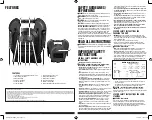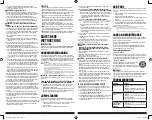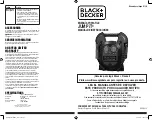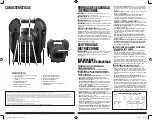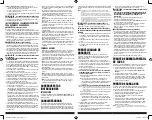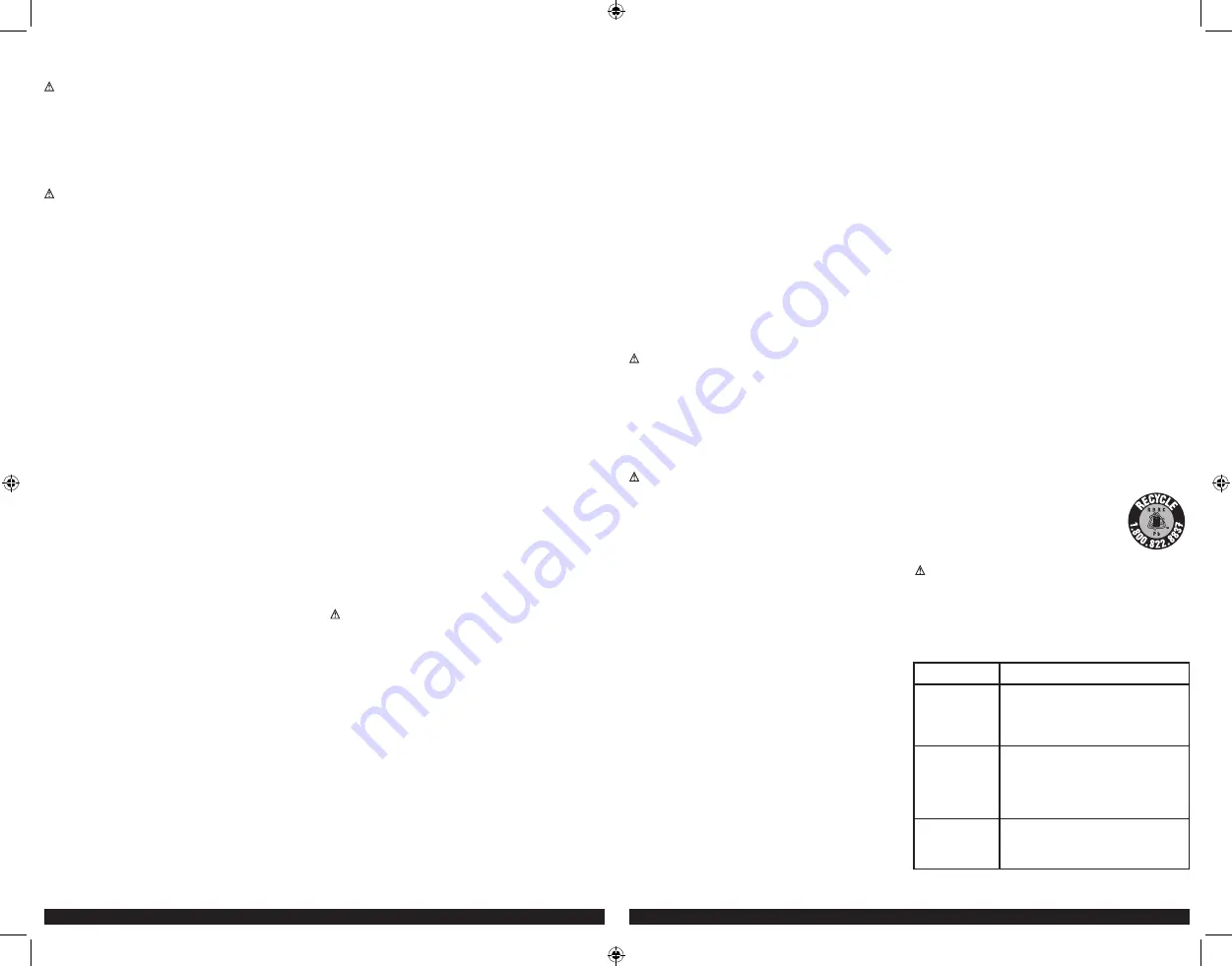
4
5
3. Remove jumper clamps from clamp tabs. Connect the red clamp first,
then the black clamp.
4. Procedure for jump-starting a NEGATIVE GROUNDED SYSTEM
(negative battery terminal is connected to chassis) (MOST COMMON)
4a. Connect positive (+) red clamp to vehicle battery’s positive terminal.
4b. Connect negative (–) black clamp to chassis or a solid, non-moving,
metal vehicle component or body part. Never clamp directly to
negative battery terminal or moving part. Refer to the automobile
owner’s manual.
5. Procedure for jump-starting POSITIVE GROUND SYSTEMS
Note:
In the rare event that the vehicle to be started has a Positive Grounded System
(positive battery terminal is connected to chassis), replace steps 4a and 4b
above with steps 5a and 5b, then proceed to step 6.
5a. Connect negative (–) black clamp to vehicle battery’s negative
terminal.
5b. Connect positive (+) red clamp to vehicle chassis or a solid, non-
moving, metal vehicle component or body part. Never clamp directly
to Positive battery terminal or moving part. Refer to the automobile
owner’s manual.
6. When clamps are connected properly, turn the Jump-Starter Power
Switch to ON.
7. Turn ON the ignition and crank the engine in 5-6 second bursts until
engine starts.
8. Turn the Jump-Starter Power Switch back to the OFF position.
9. Disconnect the negative (–) engine or chassis clamp first, then
disconnect the positive (+) battery clamp.
WARNING –
TO REDUCE THE RISK OF INJURY OR PROPERTY
DAMAGE:
•
FOLLOW ALL SAFETY INSTRUCTIONS FOUND IN THE “SPECIFIC
SAFETY INSTRUCTIONS FOR JUMP STARTERS” SECTION OF THIS
INSTRUCTION MANUAL.
• This power system is to be used ONLY on vehicles with 12 volt DC
battery systems.
• Never touch red and black clamps together — this can cause dangerous
sparks, power arcing, and/or explosion.
• After use, turn the Jump-Starter Power Switch off.
CAUTION –
TO REDUCE THE RISK OF PROPERTY DAMAGE:
• Vehicles that have on-board computerized systems may be damaged if
vehicle battery is jump-started. Before jump-starting this type of vehicle,
read the vehicle manual to confirm that external-starting assistance is
advised.
• Excessive engine cranking can damage the vehicle‘s starter motor. If
the engine fails to start after the recommended number of attempts,
discontinue jump-start procedure and look for other problems that need
to be corrected.
• If the connections to the battery’s positive and negative terminals are
incorrect, the Reverse Polarity Indicator will light and the unit will sound a
continuous alarm until the clamps are disconnected. Disconnect clamps
and reconnect to battery with correct polarity.
• If vehicle fails to start, turn off the ignition, turn off the Jump-Starter
Power Switch, disconnect the jump-start system’s leads and contact a
qualified technician to investigate why the engine did not start.
• Recharge this unit fully after each use.
12 VOLT DC PORTABLE POWER SUPPLY
This portable power source is also for use with all 12 Volt DC accessories
equipped with a male accessory outlet plug and are rated up to 5 amps.
1. Lift up the cover of the unit ‘s 12 Volt DC outlet.
2. Insert the 12 Volt DC plug from the appliance into the 12 Volt accessory
outlet on the unit. DO NOT EXCEED A 5 AMP LOAD.
3. Switch on the appliance and operate as usual.
4. Periodically press the battery power level pushbutton to check battery
status. (When all three battery status LEDs light, it indicates a full
battery. Only one red battery status indicator light indicates that the unit
needs to be recharged.)
USB PORT
The USB power port is under the same protective cover as the 12 Volt DC
outlet on the left hand side of the front panel (refer to the Features section
to locate)..
1. Push the USB power button to turn the USB port on and the USB power
indicator will light.
2. Lift up the cover of the USB charging port.
3. Plug the USB-powered device into the USB charging port and operate
normally.
4. Periodically check the unit’s battery status by pressing the battery
power level button. (When all three battery status LEDs light, it indicates
a full battery. Only one red battery status indicator light indicates that
the unit needs to be recharged.)
Notes:
This unit’s USB Power Port does not support data communication. It only provides 5
volts/2,000mA DC power to an external USB-powered device.
Make sure the USB Power Button is in the off position when the unit is being recharged or
stored.
Some household USB-powered electronics will not operate with this unit.
CARE AND MAINTENANCE
All batteries lose energy from self-discharge over time and more rapidly at
higher temperatures. When the unit is not in use, we recommend that the
battery is charged at least every 30 days.
From time to time wipe the outside of the appliance with a soft cloth. Do
not immerse the appliance in water.
There are no user-replaceable parts. Periodically inspect the condition
of adapters, connectors and wires. Contact manufacturer to replace any
components that have become worn or broken.
Battery replacement/disposal
BATTERY REPLACEMENT
The battery should last the service life of the unit. Service life is dependent
on a number of factors including but not limited to the number of recharge
cycles, and proper care and maintenance of the battery by the end user.
Contact manufacturer for any information you may need.
SAFE BATTERY DISPOSAL
Contains a maintenance-free, sealed, non-spillable, lead
acid battery, which must be disposed of properly.
Recycling is required. Failure to comply with local, state
and federal regulations can result in fines, or imprisonment.
Please recycle.
WARNINGS:
• Do not dispose of the battery in fire as this may result in an explosion.
• Before disposing of the battery, protect exposed terminals with heavy-duty
electrical tape to prevent shorting (shorting can result in injury or fire).
• Do not expose battery to fire or intense heat as it may explode.
TROUBLESHOOTING
Problem
Solution
Unit will not charge
• Make sure the power switch is in the off
position.
• Make sure a suitable gage extension cord
is properly connected to both the unit and a
functioning AC outlet.
Unit fails to jump-
start
• Make sure unit’s power switch is in the ON
position.
• Make sure a proper polarity cable connection
has been established
• Check that unit has a full charge. Recharge unit
if necessary.
12 Volt DC portable
power supply
will not power
appliance
• Make sure the appliance does not draw more
than 5 amps.
• Check that unit has a full charge. Recharge unit
if necessary.
• Use of an attachment not supplied, recommended or sold by
manufacturer specifically for use with this unit may result in a risk of
electrical shock and injury to persons.
WARNING:
RISK OF EXPLOSIVE GASES
• Working in the vicinity of a lead acid battery is dangerous. Batteries
generate explosive gases during normal battery operation. For this reason,
it is of the utmost importance that each time before using the jump-
starter you read this manual and follow instructions exactly.
• To reduce the risk of battery explosion, follow these instructions and
those published by the battery manufacturer and manufacturer of
any equipment you intend to use in the vicinity of the battery. Review
cautionary markings on these products and on the engine.
CAUTION –
TO REDUCE THE RISK OF INJURY OR PROPERTY
DAMAGE:
•
NEVER ATTEMPT TO JUMP-START OR CHARGE A FROZEN BATTERY.
• Vehicles that have on-board computerized systems may be damaged if
vehicle battery is jump-started. Before jump-starting, read the vehicle’s
owner’s manual to confirm that external-starting assistance is suitable.
• Never smoke or allow a spark or flame in vicinity of vehicle battery,
engine or power station
• Jump-start procedures should only be performed in a safe, dry, well-
ventilated area.
• Always store battery clamps when not in use. Never touch battery
clamps together. This can cause dangerous sparks, power arcing and/
or explosion.
• When using this unit close to the vehicle’s battery and engine, stand
the unit on a flat, stable surface, and be sure to keep all clamps, cords,
clothing and body parts away from moving vehicle parts.
• Never allow red and black clamps to touch each other or another
common metal conductor – this could cause damage to the unit and/or
create a sparking/explosion hazard.
–
For negative-grounded systems, connect the positive (RED) clamp to
the positive ungrounded battery post and the negative (BLACK) clamp
to the vehicle chassis or engine block away from the battery. Do not
connect the clamp to the carburetor, fuel lines or sheet-metal body
parts. Connect to a heavy gauge metal part of the frame or engine
block.
–
For positive-grounded systems, connect the negative (BLACK) clamp
to the negative ungrounded battery post and the positive (RED) clamp
to the vehicle chassis or engine block away from the battery. Do not
connect the clamp to the carburetor, fuel lines or sheet-metal body
parts. Connect to a heavy gauge metal part of the frame or engine
block.
• If the connections to the battery’s positive and negative terminals are
incorrect, the Reverse Polarity Indicator will light (red) and the unit will
sound a continuous alarm until the clamps are disconnected. Disconnect
clamps and reconnect to battery with correct polarity.
• Always disconnect the negative (BLACK) jumper cable first, followed by
the positive (RED) jumper cable, except for positive grounded systems.
• Do not expose battery to fire or intense heat since it may explode. Before
disposing of the battery, protect exposed terminals with heavy-duty
electrical tape to prevent shorting (shorting can result in injury or fire).
• Place this unit as far away from the battery as cables permit.
• Never allow battery acid to come in contact with this unit.
• Do not operate this unit in a closed area or restrict ventilation in any way.
• This system is designed to be used only on vehicles with a 12 Volt DC
battery system. Do not connect to a 6 volt or 24 volt battery system.
• This system is not designed to be used as a replacement for a vehicular
battery. Do not attempt to operate a vehicle that does not have a battery
installed.
• Excessive engine cranking can damage a vehicle’s starter motor. If
the engine fails to start after the recommended number of attempts,
discontinue jump-start procedures and look for other problems that may
need to be corrected.
• Do not use this jump-starter on a watercraft. It is not qualified for marine
applications.
• Although this unit contains a non-spillable battery, it is recommended that
unit be kept upright during storage, use and recharging. To avoid possible
damage that may shorten the unit’s working life, protect it from direct
sunlight, direct heat and/or moisture.
FIRST AID
• When working with lead acid batteries, always make sure immediate
assistance is available in case of accident or emergency.
• Always have protective eyewear when using this product: contact with
battery acid may cause blindness and/or severe burns. Be aware of first
aid procedures in case of accidental contact with battery acid.
• Have plenty of fresh water and soap nearby in case battery acid contacts
skin.
• Remove personal metal items such as rings, bracelets, necklaces and
watches when working with a lead acid battery. A lead acid battery can
produce a short circuit current high enough to weld a ring, or similar
metal object, to skin, causing a severe burn.
• Do not wear vinyl clothing when jump-starting a vehicle when jump-
starting a vehicle, friction can cause dangerous static-electrical sparks.
•
Skin:
If battery acid contacts skin or clothing, wash immediately with
soap and water for at least 10 minutes. If redness, pain, or irritation
occurs, seek immediate medical attention.
•
Eyes:
If battery acid comes in contact with eyes, flush eyes immediately,
for a minimum of 15 minutes and seek immediate medical attention.
SAVE THESE
INSTRUCTIONS
INTRODUCTION
Congratulations on purchasing your new
Black + Decker
®
Jump-Starter
.
Read this Instruction Manual and follow the instructions carefully before
using this unit.
CHARGING/RECHARGING
Lead-acid batteries require routine maintenance to ensure a full charge
and long battery life. All batteries lose energy from self-discharge over time
and more rapidly at higher temperatures. Therefore, batteries need periodic
charging to replace energy lost through self-discharge. When the unit is
not in frequent use, manufacturer recommends the battery be recharged at
least every 30 days.
Notes:
This unit is delivered in a partially charged state – you must fully charge it upon purchase
and before using it for the first time. Initial AC charge should be for 24 hours.
Recharging battery after each use will prolong battery life; frequent heavy discharges
between recharges and/or overcharging will reduce battery life. The battery can be
recharged using the Built-In 120 Volt AC Charger.
Make sure all other unit functions are turned off during recharging, as this can slow the
recharging process.
If the battery is overly discharged and the green LED lights when the charger is plugged in,
this indicates the battery is at a high impedance stage. If this occurs, recharge the unit and
leave it charging for a period of 24-48 hours before use.
CAUTION –
RISK OF PROPERTY DAMAGE:
Failure to keep the battery
charged will cause permanent damage and result in poor jump starting
performance.
Charging/Recharging Using the 120 Volt AC Charger and
a Standard Household Extension Cord (not included)
1. Lift the AC adapter cover located on the back of the unit and connect
an extension cord to the unit. Plug the other end of the cord into a
standard 120-volt AC wall outlet.
2. Charge until the green Battery Status LED Indicator lights solid or flashes.
3. Disconnect the extension cord and depress the battery status button. If
all 3 status lights illuminate, the unit is fully charged.
JUMP-STARTER
This Jump-Starter is equipped with an Jump-Starter Power Switch. Once
the connections are properly made, turn the switch on to jump-start the
vehicle.
1. Turn off vehicle ignition and all accessories (radio, A/C, lights, connected
cell phone chargers, etc.). Place vehicle in “park” and set the
emergency brake.
2. Make sure the Jump-Starter Power Switch is turned to off.
J312B_ManualENSP_061920.indd 4-5
J312B_ManualENSP_061920.indd 4-5
6/19/2020 1:49:53 PM
6/19/2020 1:49:53 PM


